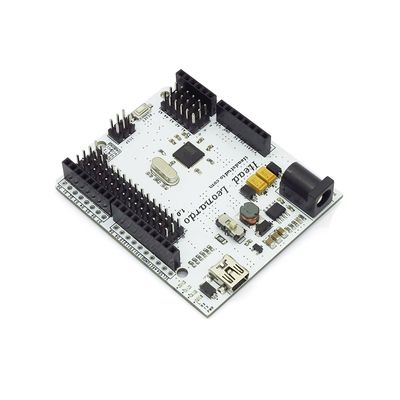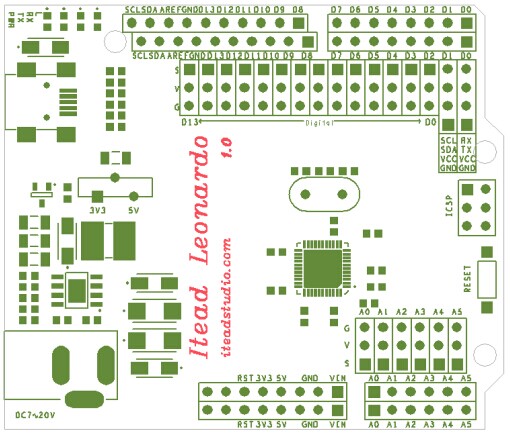Iteaduino Leonardo
Contents
Overview
Iteaduino Leonardo is a microcontroller board based on the ATmega32u4, it's 100% campatible with Arduino Leonardo. It has 20 digital input/output pins, a 16 MHz crystal oscillator, a micro USB connection, a power jack, an ICSP header, and a reset button. It contains everything needed to support the microcontroller; simply connect it to a computer with a USB cable or power it with an AC-to-DC adapter or battery to get started.
Iteaduino Leonardo differs from all preceding boards in that the ATmega32u4 has built-in USB communication, eliminating the need for a secondary processor. This allows the Leonardo to appear to a connected computer as a mouse and keyboard, in addition to a virtual (CDC) serial / COM port. It also has other implications for the behavior of the board.
Features
- Efficient DC-DC Power supply with wide range input.
- 3.3V/5V Operating Voltage selection
- All pins out for Sensor and Servo
- UART/IIC interface breakout
- All electronic brick socket are broken out
Spec
| Microprocessor | ATmega32U4 |
| PCB Size | 68.58mm X 58.42mm X 1.6mm |
| Indicators | Power,TX,RX,L |
| Power supply(recommended) | 7-23V DC |
| Power supply(limits) | 23 VDC(max) |
| Communication Protocol | UART,SPI,IIC |
| Clock Speed | 16MHz |
| RoHS | Yes |
Electrical Characteristics
| Specification | Min | Type | Max | Unit |
| Input voltage | 7 | - | 23 | VDC |
| Operating Voltage | - | 3.3/5 | - | VDC |
| DC Current per I/O Pin | - | 40 | - | mA |
Hardware
Digital/Servo Interface: D0~D13 pin
Sensor Interface: A0 A1 A2 A3 A4 A5 pin
Pin Map
| Index | Name of Arduino | Alternate Function | Pin of Atmega32u4 |
| 1 | D0 | UART DIN | PD2 |
| 2 | D1 | UART DOUT | PD3 |
| 3 | D2 | IIC_SDA | PD1 |
| 4 | D3 | IIC_SCL/PWM | PD0 |
| 5 | D4 | External Interrupt 0/A6 | PD4 |
| 6 | D5 | External Interrupt 1/PWM | PC5 |
| 7 | D6 | PWM | PD7 |
| 8 | D7 | A7 | PE6 |
| 9 | D8 | A8 | PB4 |
| 10 | D9 | PWM/A9 | PB5 |
| 11 | D10 | PWM/A10 | PB6 |
| 12 | D11 | PWM | PB7 |
| 13 | D12 | A11 | PD6 |
| 14 | D13 | PWM | PC7 |
| 15 | A0 | PF7 | |
| 16 | A1 | PF6 | |
| 17 | A2 | PF5 | |
| 18 | A3 | PF4 | |
| 19 | A4 | PF1 | |
| 20 | A5 | PF0 |
Power Supply
The Arduino Leonardo can be powered via the micro USB connection or with an external power supply. The power source is selected automatically.
External (non-USB) power can come either from an AC-to-DC adapter (wall-wart) or battery. The adapter can be connected by plugging a 2.1mm center-positive plug into the board's power jack. Leads from a battery can be inserted in the Gnd and Vin pin headers of the POWER connector.
The board can operate on an external supply of 7 to 23 volts. If supplied with less than 7V, however, the 5V pin may supply less than five volts and the board may be unstable.
The power pins are as follows:
- VIN. The input voltage to the Iteaduino board when it's using an external power source (as opposed to 5 volts from the USB connection or other regulated power source). You can supply voltage through this pin, or, if supplying voltage via the power jack, access it through this pin.
- 5V. The regulated power supply used to power the microcontroller and other components on the board. This can come either from VIN via an on-board regulator, or be supplied by USB or another regulated 5V supply.
- 3V3. A 3.3 volt supply generated by the on-board regulator. Maximum current draw is 250 mA.
- GND. Ground pins.
- IOREF. The voltage at which the i/o pins of the board are operating (i.e. VCC for the board). This is 5V on the Iteaduino Leonardo.
Memory
Input and Output
Communication
Programming
Automatic (Software) Reset and Bootloader
Initiation
USB Over-current Protection
Physical Characteristics
Download
Datasheet for Iteaduino Leonardo
Schematic for Iteaduino Leonardo
Fritzing Parts for Iteaduino Leonardo
 Notice
Notice
